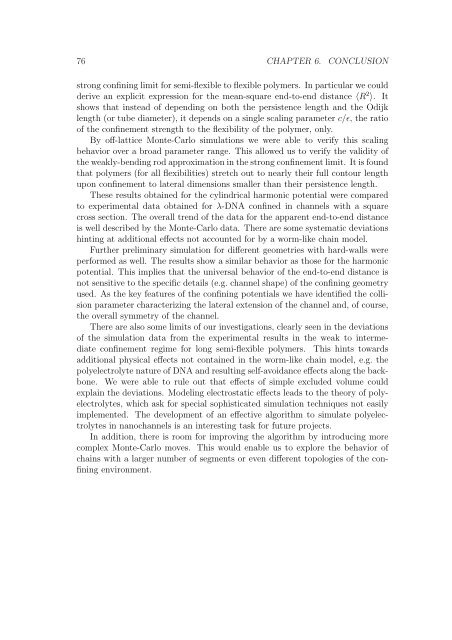Polymers in Confined Geometry.pdf
Polymers in Confined Geometry.pdf
Polymers in Confined Geometry.pdf
Create successful ePaper yourself
Turn your PDF publications into a flip-book with our unique Google optimized e-Paper software.
76 CHAPTER 6. CONCLUSION<br />
strong conf<strong>in</strong><strong>in</strong>g limit for semi-flexible to flexible polymers. In particular we could<br />
derive an explicit expression for the mean-square end-to-end distance 〈R 2 〉. It<br />
shows that <strong>in</strong>stead of depend<strong>in</strong>g on both the persistence length and the Odijk<br />
length (or tube diameter), it depends on a s<strong>in</strong>gle scal<strong>in</strong>g parameter c/ɛ, the ratio<br />
of the conf<strong>in</strong>ement strength to the flexibility of the polymer, only.<br />
By off-lattice Monte-Carlo simulations we were able to verify this scal<strong>in</strong>g<br />
behavior over a broad parameter range. This allowed us to verify the validity of<br />
the weakly-bend<strong>in</strong>g rod approximation <strong>in</strong> the strong conf<strong>in</strong>ement limit. It is found<br />
that polymers (for all flexibilities) stretch out to nearly their full contour length<br />
upon conf<strong>in</strong>ement to lateral dimensions smaller than their persistence length.<br />
These results obta<strong>in</strong>ed for the cyl<strong>in</strong>drical harmonic potential were compared<br />
to experimental data obta<strong>in</strong>ed for λ-DNA conf<strong>in</strong>ed <strong>in</strong> channels with a square<br />
cross section. The overall trend of the data for the apparent end-to-end distance<br />
is well described by the Monte-Carlo data. There are some systematic deviations<br />
h<strong>in</strong>t<strong>in</strong>g at additional effects not accounted for by a worm-like cha<strong>in</strong> model.<br />
Further prelim<strong>in</strong>ary simulation for different geometries with hard-walls were<br />
performed as well. The results show a similar behavior as those for the harmonic<br />
potential. This implies that the universal behavior of the end-to-end distance is<br />
not sensitive to the specific details (e.g. channel shape) of the conf<strong>in</strong><strong>in</strong>g geometry<br />
used. As the key features of the conf<strong>in</strong><strong>in</strong>g potentials we have identified the collision<br />
parameter characteriz<strong>in</strong>g the lateral extension of the channel and, of course,<br />
the overall symmetry of the channel.<br />
There are also some limits of our <strong>in</strong>vestigations, clearly seen <strong>in</strong> the deviations<br />
of the simulation data from the experimental results <strong>in</strong> the weak to <strong>in</strong>termediate<br />
conf<strong>in</strong>ement regime for long semi-flexible polymers. This h<strong>in</strong>ts towards<br />
additional physical effects not conta<strong>in</strong>ed <strong>in</strong> the worm-like cha<strong>in</strong> model, e.g. the<br />
polyelectrolyte nature of DNA and result<strong>in</strong>g self-avoidance effects along the backbone.<br />
We were able to rule out that effects of simple excluded volume could<br />
expla<strong>in</strong> the deviations. Model<strong>in</strong>g electrostatic effects leads to the theory of polyelectrolytes,<br />
which ask for special sophisticated simulation techniques not easily<br />
implemented. The development of an effective algorithm to simulate polyelectrolytes<br />
<strong>in</strong> nanochannels is an <strong>in</strong>terest<strong>in</strong>g task for future projects.<br />
In addition, there is room for improv<strong>in</strong>g the algorithm by <strong>in</strong>troduc<strong>in</strong>g more<br />
complex Monte-Carlo moves. This would enable us to explore the behavior of<br />
cha<strong>in</strong>s with a larger number of segments or even different topologies of the conf<strong>in</strong><strong>in</strong>g<br />
environment.













